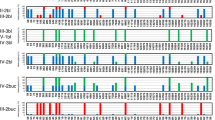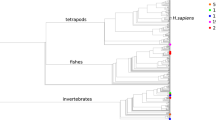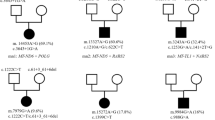Abstract
Mitochondrial disease can be attributed to both mitochondrial and nuclear gene mutations. It has a heterogeneous clinical and biochemical profile, which is compounded by the diversity of the genetic background. Disease-based epidemiological information has expanded significantly in recent decades, but little information is known that clarifies the aetiology in African patients. The aim of this study was to investigate mitochondrial DNA variation and pathogenic mutations in the muscle of diagnosed paediatric patients from South Africa. A cohort of 71 South African paediatric patients was included and a high-throughput nucleotide sequencing approach was used to sequence full-length muscle mtDNA. The average coverage of the mtDNA genome was 81±26 per position. After assigning haplogroups, it was determined that although the nature of non-haplogroup-defining variants was similar in African and non-African haplogroup patients, the number of substitutions were significantly higher in African patients. We describe previously reported disease-associated and novel variants in this cohort. We observed a general lack of commonly reported syndrome-associated mutations, which supports clinical observations and confirms general observations in African patients when using single mutation screening strategies based on (predominantly non-African) mtDNA disease-based information. It is finally concluded that this first extensive report on muscle mtDNA sequences in African paediatric patients highlights the need for a full-length mtDNA sequencing strategy, which applies to all populations where specific mutations is not present. This, in addition to nuclear DNA gene mutation and pathogenicity evaluations, will be required to better unravel the aetiology of these disorders in African patients.
Similar content being viewed by others
Log in or create a free account to read this content
Gain free access to this article, as well as selected content from this journal and more on nature.com
or
Accession codes
References
Skladal D, Halliday J, Thorburn DR : Minimum birth prevalence of mitochondrial respiratory chain disorders in children. Brain 2003; 126: 1905–1912.
Anderson S, Bankier AT, Barrell BG et al: Sequence and organization of the human mitochondrial genome. Nature 1981; 290: 457–465.
Reinecke F, Smeitink JAM, van der Westhuizen FH : OXPHOS gene expression and control in mitochondrial disorders. Biochim Biophys Acta 2009; 1792: 1113–1121.
Zeviani M, Di Donato S : Mitochondrial disorders. Brain 2004; 127: 2153–2172.
Swalwell H, Kirby DM, Blakely EL et al: Respiratory chain complex I deficiency caused by mitochondrial DNA mutations. Eur J Hum Genet 2011; 19: 769–775.
Tuppen HA, Blakely EL, Turnbull DM, Taylor RW : Mitochondrial DNA mutations and human disease. Biochim Biophys Acta 2010; 1797: 113–128.
Elliott HR, Samuels DC, Eden JA, Relton CL, Chinnery PF : Pathogenic mitochondrial DNA mutations are common in the general population. Am J Hum Genet 2008; 83: 254–260.
Smuts I, Louw R, du Toit H, Klopper B, Mienie LJ, van der Westhuizen FH : An overview of a cohort of South African patients with mitochondrial disorders. J Inherit Metab Dis 2010; e-pub ahead of print 5 February 2010; doi:10.1007/s10545-009-9031-8.
Wolf NI, Smeitink JAM : Mitochondrial disorders: a proposal for consensus diagnostic criteria in infants and children. Neurology 2002; 59: 1402–1405.
Rahman S, Blok RB, Dahl HH et al: Leigh syndrome: clinical features and biochemical and DNA abnormalities. Ann Neurol 1996; 39: 343–351.
Janssen AJ, Trijbels FJ, Sengers RC et al: Spectrophotometric assay for complex I of the respiratory chain in tissue samples and cultured fibroblasts. Clin Chem 2007; 53: 729–734.
Shepherd D, Garland PB : The kinetic properties of citrate synthase from rat liver mitochondria. Biochem J 1969; 114: 597–610.
Taylor RW, Taylor GA, Durham SE, Turnbull DM : The determination of complete human mitochondrial DNA sequences in single cells: implications for the study of somatic mitochondrial DNA point mutations. Nucleic Acids Res 2001; 29: 15e74.
Hedges D, Burges D, Powell E et al: Exome sequencing of a multigenerational human pedigree. PLoS One 2009; 4: e8232.
Zaragoza MV, Fass J, Diegoli M, Lin D, Arbustini E : Mitochondrial DNA variant discovery and evaluation in human cardiomyopathies through next-generation sequencing. PLoS One 2010; 5: e12295.
De Schrijver JM, De Leeneer K, Lefever S et al: Analysing 454 amplicon resequencing experiments using the modular and database oriented variant identification pipeline. BMC Bioinform 2010; 11: 269.
Pereira L, Freitas F, Fernandes V et al: The diversity present in 5140 human mitochondrial genomes. Am J Hum Genet 2009; 84: 628–640.
McFarland R, Elson JL, Taylor RW, Howell N, Turnbull DM : Assigning pathogenicity to mitochondrial tRNA mutations: when ‘definitely maybe’ is not good enough. Trends Genet 2004; 20: 591–596.
Joyjinda Y : The role of mitochondrial background in the expression of Leber hereditary optic neuropathy. Masters thesis, Mahidol University, Mahidol, Thailand, 2007.
Porcelli AM, Ghelli A, Ceccarelli C : The genetic and metabolic signature of oncocytic transformation implicates HIF1 destabilization. Hum Mol Genet 2010; 19: 1019–1032.
Prasad GN, Vanniarajan A, Emmanuel C, Cherian KM, Singh L, Thangaraj K : Novel mitochondrial DNA mutations in a rare variety of hypertrophic cardiomyopathy. Int J Cardiol 2006; 109: 432–433.
Bandelt H, Yao Y, Salas A : The search of ‘novel’ mtDNA mutations in hypertrophic cardiomyopathy: MITOMAPping as a risk factor. Int J Cardiol 2008; 126: 439–442.
Howell N, Kubacka I, Xu M, Mccullough DA : Leber hereditary optic neuropathy: involvement of the mitochondrial ND I gene and evidence for an intragenic suppressor mutation. Am J Hum Genet 1991; 48: 935–942.
Howell N, Kubacka I, Halvorson S, Howell B, Mccullough DA, Mackey D : Phylogenetic analysis of the mitochondrial genomes from Leber hereditary optic neuropathy pedigrees. Genetics 1995; 140: 285–302.
Mackey DA : Three subgroups of patients from the United Kingdom with Leber hereditary optic neuropathy. Eye 1994; 8: 431–436.
Pye D, Kyriakouli DS, Taylor GA et al: Production of transmitochondrial cybrids containing naturally occurring pathogenic mtDNA variants. Nucleic Acids Res 2006; 34: e95.
Hernstadt C, Elson JL, Fahy E et al: Reduced-median-network analysis of complete mitochondrial DNA coding-region sequences for the major African, Asian, and European haplogroups. Am J Hum Genet 2002; 70: 1152–1171.
Chandrasekar A, Kumar S, Sreenath J et al: Updating phylogeny of mitochondrial DNA macrohaplogroup M in India: dispersal of modern human in South Asian corridor. PLoS One 2009; 4: e7447.
Petros JA, Baumann AK, Ruiz-Pesini E et al: mtDNA mutations increase tumorigenicity in prostate cancer. Proc Natl Acad Sci USA 2005; 102: 719–724.
Gomez-Duran A, Pacheu-Grau D, Lopez-Gallardo E et al: Unmasking the causes of multifactorial disorders: OXPHOS differences between mitochondrial haplogroups. Hum Mol Genet 2010; 19: 3343–3353.
Human H, Hagen CM, De Jong G et al: Investigation of mitochondrial sequence variants associated with aminoglycoside-induced ototoxicity in South African TB patients on aminoglycosides. Biochem Biophys Res Commun 2010; 393: 751–756.
Alston CL, Lowe J, Turnbull DM, Maddison P, Taylor RW : A novel mitochondrial tRNA(Glu) (MTTE) gene mutation causing chronic progressive external ophthalmoplegia at low levels of heteroplasmy in muscle. J Neurol Sci 2010; 298: 140–144.
Johns DR, Neufeld MJ, Park RD : An ND-6 mitochondrial DNA mutation associated with Leber hereditary optic neuropathy. Biochem Biophys Res Commun 1992; 187: 1551–1557.
Bannwarth S, Procaccio V, Rouzier C et al: Rapid identification of mitochondrial DNA (mtDNA) mutations in neuromuscular disorders by using surveyor strategy. Mitochondrion 2008; 8: 136–145.
Coble MD, Just RS, O’Callaghan JE et al: Single nucleotide polymorphisms over the entire mtDNA genome that increase the power of forensic testing in Caucasians. Int J Legal Med 2004; 118: 137–146.
Kivisild T, Shen P, Wall DP et al: The role of selection in the evolution of human mitochondrial genomes. Genetics 2006; 172: 373–387.
Taylor RW, Giordano C, Davidson MM et al: A homoplasmic mitochondrial transfer ribonucleic acid mutation as a cause of maternally inherited hypertrophic cardiomyopathy. J Am Coll Cardiol 2003; 21: 1786–1796.
He Y, Wu J, Dressman DC et al: Heteroplasmic mitochondrial DNA mutations in normal and tumour cells. Nature 2010; 464: 610–614.
Li M, Schönberg A, Schaefer M et al: Detecting heteroplasmy from high-throughput sequencing of complete human mitochondrial DNA genomes. Am J Hum Genet 2010; 87: 237–249.
Acknowledgements
We acknowledge the supporting contribution of the clinical staff of the Department of Paediatrics and Child Health, Steve Biko Academic Hospital, University of Pretoria, South Africa, as well as Charlotte Alston, Emma Watson and John Yarham of the Mitochondrial Research Group, Institute for Ageing and Health, Newcastle University. We are grateful for the financial support of the Department of Science and Technology and Medical Research Council of South Africa. RWT and DMT are funded by a Wellcome Trust Programme Grant (074454/Z/04/Z) and the UK NHS Specialised Services ‘Rare Mitochondrial Disorders of Adults and Children’ Diagnostic Service (http://www.mitochondrialncg.nhs.uk). FHvdW is supported by a Newcastle University Research Committee Visiting Professorship bursary.
Author information
Authors and Affiliations
Corresponding author
Ethics declarations
Competing interests
The authors declare no conflict of interest.
Additional information
Supplementary Information accompanies the paper on European Journal of Human Genetics website
Rights and permissions
About this article
Cite this article
van der Walt, E., Smuts, I., Taylor, R. et al. Characterization of mtDNA variation in a cohort of South African paediatric patients with mitochondrial disease. Eur J Hum Genet 20, 650–656 (2012). https://doi.org/10.1038/ejhg.2011.262
Received:
Revised:
Accepted:
Published:
Issue date:
DOI: https://doi.org/10.1038/ejhg.2011.262
Keywords
This article is cited by
-
Leber’s hereditary optic neuropathy plus dystonia caused by the mitochondrial ND1 gene m.4160 T > C mutation
Neurological Sciences (2022)
-
Mitochondrial disease patients with novel ND4 12058A > C and ND1 m.3911A > G variations: implications for a role in the phenotype following a bioinformatic investigation
Molecular Biology Reports (2021)
-
Human origins in a southern African palaeo-wetland and first migrations
Nature (2019)
-
Haplogroup Context is Less Important in the Penetrance of Mitochondrial DNA Complex I Mutations Compared to mt-tRNA Mutations
Journal of Molecular Evolution (2018)



